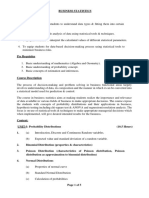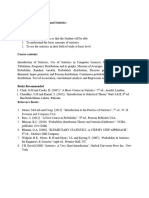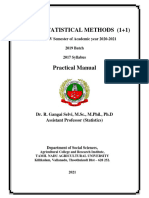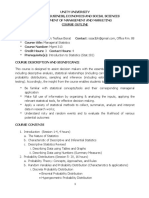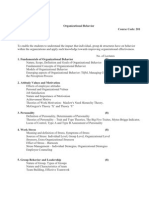0 ratings0% found this document useful (0 votes)
2 viewsData Structure and Algorithms
SYLLABUS
Uploaded by
yopax90880Copyright
© © All Rights Reserved
Available Formats
Download as PDF or read online on Scribd
0 ratings0% found this document useful (0 votes)
2 viewsData Structure and Algorithms
SYLLABUS
Uploaded by
yopax90880Copyright
© © All Rights Reserved
Available Formats
Download as PDF or read online on Scribd
You are on page 1/ 3
PEPE EFEEEEEEEEEEEEEE
Course Title: Probability & Statisties (3 Cr.)
Course Code: CACS202
Year/Semester: I/II
Class Lond: 5 Hrs. / Week (Theory: 3 Hrs, Tutorial: 1 Hr., Practi
1 Hr.)
Course Deseription
‘his course covers basic concept of statistics, measurement of central tendency,
correlation & regression analysis. probability, sample surve
methods and design of experimer
ample survey
t. ‘These topics are essential tools for research,
al objectives of this course are to provide fundamental concept of
ies, Probability, Sample Survey and their applications in the area of
and Computer Application,
Social
Content
Unit 1 Introduction to Statisties 3 Hrs,
Meaning, Scope and Limitations of §
Methods and Problems of Coll
tisties, Types
tion of Primary and Secondary Data.
and Sources of Data,
2 Descriptive Statistics 6Hrs.
Measure of Cen
ral Tendency (Arithmetic Mean, Median, Partition Valu
Mode); Measure of Dispersion (Absolute and Relative Measures Range, Quartile
Deviation, Mean Deviation, Standard Deviation, and Coefficient of Variation)
Unit 3 Correlation and Regression An:
is 6 Hrs,
Corre Definition, Scatter diagram, Karl Pearson's coefficient of
correlation, Numerical problems for determination of Correlation Coefficients.
Regression: Definition, Dependent and Independent Variables, Least Square
method only, Numerical Problems,
4 Probability 8 Hrs.
Definition of Probability, Two basic Laws of Probability( without proof),
Conditional Probability: Probability Distributions (Binomial, Poisson and
Normal); simple numerical problems,
Sample s
rvey
Concept of Population and Sample: Needs of Sampli
Survey: Basie Concept of
Consuse
Sampling: Organizational Aspect of le Survey
Questionnaire Design: Sample Selection and Determination of Sample Size.
Sampling and Non Sampling Effoxs.
6Sample Survey Methods 10 Hi
Types of Sampling: Simple Random Sampling
with and without Replacement;
Stratified Random Sampling: Ratio and R
sion Method of Estimation under
Simple and Stratified Random Sampling: Systematic Sampling: Cluster
Sampling: Multistage Sampling; Probability Proportion to Size Sau
Estimation of Population Total and its Variance, Sampling Distr
and Related Problems.
Unit 7 Design of Experiment 6 Hrs
Concept of Analysis of Variance (ANOVA), F -Statistic and its Distribution,
Limear Model in ANOVA, Analysis of One Way, Iwo Way Classification (1 and
m observations per cell) in Fixed Effect Model,
Laboratory Works
Techniques for using the computer as a tool in the analysis of stati
will be introduced. SPSS software should be used for data analysis
1 problems
1¢ Methods
he general teaching pedagogy includes class lectures, group discussions, case
studies, guest lectures, research work, project work, assignments (theoretical and
Practical), and examinations (written and verbal), depending upon the nature of
the topics. The teaching faculty will determine the choice of teaching pedagogy
as per the need of the topics.
Examination Scheme
Internal Assessment | External
sssment
Theory | Practical | Theory | Practical | Total
20 20 60 a 100
GH) | GHrs)
Vext Books
1, Mukhopadhyay P., “Theory and Methods of Survey Sany
India, New Delhi, 1998.
2. Sheldon M. Ross, “Introduction to Probability and Statistics for Engineers and
Scientists”, 3" Fdition, India, Ackdemic Press, 2005
ling”. Prentice Hall of
1. Cochran W.G., “Sampling Techniques”, 3" edition, John Wileyand Sons, Inc.
New York, 1977. Pe )
Ke y/
& PIX
Y
ity and Statistical Inference”, 6" edition, First Indian
Reprint, 2002
Montgomery Douglas C., “Design and Analysis of Experiments”, 5 edition, John
Wiley & Sons Inc, 2001
Upadhayay, H. P., Paudel, KC & et al
Pinnacle Publication,
jements of Business Mathematics
2 Lae
(
You might also like
- A192 2. Syllabus SQQS1013 Student VersionNo ratings yetA192 2. Syllabus SQQS1013 Student Version4 pages
- Indian Institute of Foreign Trade, Kakinada Program Name and Batch: BBA (FT) 2022-25 Course Name: Introductory StatisticsNo ratings yetIndian Institute of Foreign Trade, Kakinada Program Name and Batch: BBA (FT) 2022-25 Course Name: Introductory Statistics5 pages
- MATH 120 - Elementary Statistics and Probability Course Outline Time Frame (By Week) Topic/Task Desired Learning Outcomes (DLO)No ratings yetMATH 120 - Elementary Statistics and Probability Course Outline Time Frame (By Week) Topic/Task Desired Learning Outcomes (DLO)7 pages
- StatisticsComplementarytoMathematics1530104885 PDFNo ratings yetStatisticsComplementarytoMathematics1530104885 PDF7 pages
- 07 - Revised - Business Statistics 2022-24 - 10-10-2022No ratings yet07 - Revised - Business Statistics 2022-24 - 10-10-20225 pages
- Haramaya University College of Computing and Informatics Department of StatisticsNo ratings yetHaramaya University College of Computing and Informatics Department of Statistics2 pages
- 1probability and Statistics For Pre-Engineers Course OutlineNo ratings yet1probability and Statistics For Pre-Engineers Course Outline3 pages
- Syllabus: M. Sc. Statistics Entrance Test 2011-12No ratings yetSyllabus: M. Sc. Statistics Entrance Test 2011-123 pages
- University of Dhaka Department of Statistics Syllabus For 4-Year B.S. (Honors) Starting Sessions: 2017-2018No ratings yetUniversity of Dhaka Department of Statistics Syllabus For 4-Year B.S. (Honors) Starting Sessions: 2017-201845 pages
- Complementary Course Statistics for PsychologyNo ratings yetComplementary Course Statistics for Psychology7 pages
- BM 105 Quantitative Methods and StatisticsNo ratings yetBM 105 Quantitative Methods and Statistics6 pages
- STA 201 Statistics Common Practical Manual 2019No ratings yetSTA 201 Statistics Common Practical Manual 2019144 pages
- Syllabus SP 20 Stat 300 Hybrid (8 Weeks) SundayNo ratings yetSyllabus SP 20 Stat 300 Hybrid (8 Weeks) Sunday7 pages
- STAT 220: Engineering Statistics: United Arab Emirates University College of Business and Economics Spring 2011No ratings yetSTAT 220: Engineering Statistics: United Arab Emirates University College of Business and Economics Spring 20113 pages
- B.A - B.SC - Statistics - Semester - Pattern2013 PDFNo ratings yetB.A - B.SC - Statistics - Semester - Pattern2013 PDF17 pages
- Introduction To Statistics Fall 2020: Teacher Name: Dr. Saqib Ur RehmanNo ratings yetIntroduction To Statistics Fall 2020: Teacher Name: Dr. Saqib Ur Rehman3 pages
- Universiti Utara Malaysia College of Arts and Sciences School of Quantitative SciencesNo ratings yetUniversiti Utara Malaysia College of Arts and Sciences School of Quantitative Sciences3 pages
- School of Engineering and Computer Science Independent University, Bangladesh Course No: MAT 211 Course Title: Probability and Statistics Autumn 2013No ratings yetSchool of Engineering and Computer Science Independent University, Bangladesh Course No: MAT 211 Course Title: Probability and Statistics Autumn 20134 pages
- Course Description Probability Statistics UpdatedNo ratings yetCourse Description Probability Statistics Updated4 pages
- E-Note_24354_Content_Document_20240917024357PMNo ratings yetE-Note_24354_Content_Document_20240917024357PM4 pages
- Course Description: Mekelle University College of Business and Economics Department of Marketing ManagementNo ratings yetCourse Description: Mekelle University College of Business and Economics Department of Marketing Management4 pages
- Course Outline Probability and StatisticsNo ratings yetCourse Outline Probability and Statistics4 pages











